Make your lawn the envy of your neighbors with the best grass seeds for your yard’s conditions.
BobVila.com and its partners may earn a commission if you purchase a product through one of our links.
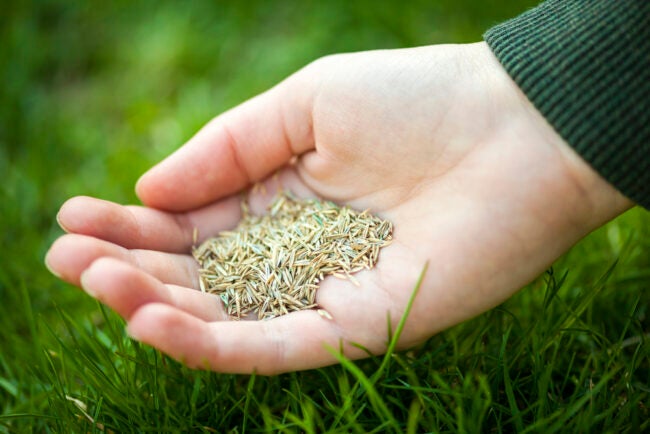
Photo: depositphotos.com
Many homeowners dream of a lush, green carpet of grass upon which your children and pets can frolic. But achieving that goal can sometimes be fraught with challenging growing conditions. Disease, pests, drought, and scorching temperatures can quickly lay waste to a yard. Growing a lawn that makes your neighbors green with envy begins with choosing the right grass seed.
There is a seemingly endless variety of different seed types and products on the market, which can make choosing the right one an involved process. Climate, shade, and foot traffic all play roles in which grass seed is the right pick for your lawn. This guide reviews the factors you should consider when it comes to choosing the best grass seed that will turn your yard into a striking carpet of green.
- BEST OVERALL: Scotts Turf Builder Thick’R Lawn Sun & Shade – 3 in 1
- BEST FOR SUNNY SPACES: Scotts Turf Builder Grass Seed Sunny Mix, 3 lbs
- BEST FOR WARM SEASON: Scotts Turf Builder Grass Seed Southern Gold Mix
- BEST FOR COOL SEASON: Jonathan Green 10323 Black Beauty Ultra Mixture
- BEST FOR DENSE SHADE: Pennington Smart Seed Dense Shade, 3 lb
- BEST FOR HIGH TRAFFIC: Scotts Turf Builder Grass Seed High Traffic Mix
- BEST KENTUCKY BLUEGRASS: Scotts Turf Builder Grass Seed Kentucky Bluegrass Mix
- BEST BERMUDA GRASS: Scotts 18353 Turf Builder Bermudagrass, 5 lb
- BEST FAST GROWING: Pennington Smart Seed Perennial Rye, 3 lb
- BEST LOW MAINTENANCE: Scotts Turf Builder Zoysia Grass Seed and Mulch, 5 lb
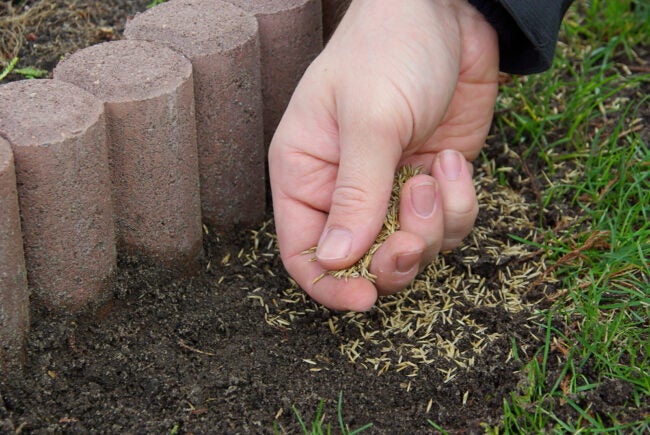
Photo: depositphotos.com
Popular Types of Grass Seed
Grass seed falls into two main categories: warm-season and cool-season grasses. Warm-season grasses endure hot southern climates much better than cool-season grasses. During the winter, warm-season grasses turn brown as they go dormant. Cool-season grasses grow quickly in the cool weather of fall and spring before going dormant in the summer heat. Warm-season grasses can be reseeded during the spring and summer, while spring and fall are the optimal time to reseed cool-season grasses.
Warm Season
- Bahia: This warm-season grass is popular in hot climates because of its heat tolerance and drought-resistant qualities. While other grasses burn to a crisp in the hot sun, with its broad leaves and coarse texture, Bahia grass thrives. This makes it an attractive grass species in the Deep South.
- Bermuda: As with many other warm-season grasses, Bermuda grass thrives in hot climates thanks to its exceptional ability to tolerate heat and withstand high traffic. Bermuda grass requires good drainage, full sun exposure, and plenty of nutrients. The grass does not tolerate cold weather well, making it a good option in the southern part of the country.
- Buffalo: Even though it is considered a warm-season grass, buffalo grass thrives in a broad range of climates and is quite common in states such as Montana that experience harsh winters. Like other warm-season grasses, it goes dormant and turns brown in colder weather. Planting season for buffalo grass is from April to May.
- Centipede: Centipede grass is known for being heat tolerant and very low-maintenance. This makes it a popular grass with those who don’t enjoy spending a lot of time managing their lawns. Centipede thrives in full sun but will tolerate some shade. Due to those requirements, it does best in the Southeast. Plant centipede grass seed in the spring when all danger of frost has passed.
- St. Augustine: As its name suggests, St. Augustine is one of Florida’s most popular grasses. This is because it can tolerate high heat and humidity. It features blue-green grass blades that spread quickly through a lawn. St. Augustine also can tolerate salt water, which makes it a popular option for coastal yards. Since it spreads rapidly, one of the most effective ways to establish St. Augustine grass is by planting plugs. Plant St. Augustine seed in the spring or summer.
- Zoysia: Zoysia is a tough variety of grass. It’s known for its ability to stand up to heat, drought, and high foot traffic. Zoysia forms a dense lawn that chokes out weeds with very little maintenance required. Although some types of zoysia can only be grown from sod or plugs, some grass seed companies offer a variety that can grow from seed. Zoysia grass should be planted in the spring once the threat of frost has passed.
Cool Season
- Fescue: Tall fescue grass is perhaps the most common grass type in the country. This is because it adapts well to many different climates as it tolerates heat, cold, shade, and drought reasonably well. This is primarily due to a root system that can reach as deep as two to three feet. Tall fescue is easy to establish but can suffer under heavy traffic. Plant and reseed tall fescue in the fall and spring.
- Kentucky Bluegrass: This is the type of grass most people imagine when they consider the perfect lawn. With its lush deep green appearance, Kentucky bluegrass is a prized species. This grass is not easy to grow, requiring a high level of maintenance and care. Its shallow root system does not tolerate heat well, making it more suitable for northern lawns. Kentucky bluegrass should be planted and reseeded in the spring and fall.
- Perennial Ryegrass: Perennial ryegrass should not be confused with annual ryegrass, a temporary grass used for erosion control. Perennial ryegrass comes back year after year. Ryegrass germinates quickly, making it popular for new lawns. It does best in colder climates with mild summers; however, it can still be found in the southern part of the country. Perennial ryegrass should be planted or reseeded in the fall.
What to Consider When Choosing the Best Grass Seed
When deciding which grass seed is best for your lawn, it’s crucial to consider several important factors, including climate, maintenance, and sun requirements. Check below for some of the elements you should consider when purchasing grass seed.
Climate
With enough determination and money, you can grow most of the above grass seeds just about anywhere in the country. It’s not uncommon to see beautiful Kentucky bluegrass lawns in the baking heat of the Southwest. But going against climate guidelines will make the job a lot harder and more expensive, requiring significant investments in irrigation systems, water, and fertilizers. Paying attention to climate will make establishing a lawn much more manageable. Consider where you live and what grass types will thrive in your region with minimal maintenance and watering.
Reseeding vs. New Planting
How you go about reseeding a lawn versus planting a new lawn is quite different. When seeding a new lawn, you’ll be applying seed to the bare dirt you’ve prepared for new planting. For reseeding, you’ll be attempting to thicken an already existing lawn. With that in mind, you typically need about twice as much seed to start a new lawn as you need to reseed an existing lawn.
Traffic Level
Grass types vary in how well they tolerate foot traffic. If you have kids or pets and plan to use your backyard extensively as an area for play, consider selecting grass types that can take some abuse and still keep on growing. Zoysia and Bermuda grasses are the most tolerant of foot traffic, while fescue does poorly with heavy traffic.
Required Maintenance
While some property owners enjoy fussing over their lawns, many homeowners dread long hours spent maintaining a yard. Consider which grass types require the least amount of care and how much work you’re willing to put into a lawn. Zoysia grass, for example, requires annual dethatching, while perennial ryegrass will not self-repair and requires patching. Bermuda grass, in comparison, requires very little maintenance.
Sun Exposure
Various grasses tolerate different levels of sun exposure. Some grasses, such as Bermuda grass, demand full sun but other varieties, such as tall fescue, do well with partial shade. Assess the sun exposure of your lawn and determine what kind of grass seed you should use. Some seed companies produce specific seed mixes for full shade, full sun, or lawns with shaded areas and full-sun areas.
Single Seed vs. Mix
When selecting a type of grass seed, you can choose one specific seed type or a blend that combines several different species. Go for a single seed type if you’re trying to achieve a particular look for your lawn. While single seeds are more difficult to maintain, the effect of a single species lawn can be well worth it.
Mixes are easier to grow and maintain because companies blend the mixes for improved drought or heat tolerance. They also generally grow more uniformly with little need for patching. However, your lawn will lack the attractive uniform look of a single species lawn.
Germination Percentage
Despite your best efforts to prepare your yard for seeding, some seeds simply weren’t meant to become plants. This is where germination percentage comes into play. Germination percentage is a measure of the viability of a collection of seeds. It is calculated by dividing the number of seeds that germinate by the total number of seeds. Given how much grass seed can cost, the higher the germination percentage, the better, and it mostly relates to seed quality. Although you might be tempted to buy a cheaper bag of grass seed, chances are it will have a lower germination percentage, resulting in significant waste. High-quality grass seed has a 90 to 95 percent germination rate, making it worth the additional investment.
Our Top Picks
You can find grass seed for sunny areas, shade, high traffic, hot and cold climates, and more. These top grass seed picks cover lots of lawn and grass types to suit various uses.
Best Overall
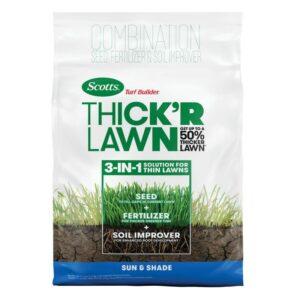
Successfully reseeding a lawn often involves the laborious process of prepping the soil and adding fertilizer before finally spreading the seed. Scotts reduces those three steps to one with its Thick’R Lawn Sun and Shade 3-In-1 seed. This product improves the chances that your seed will germinate, grow, and flourish by mixing the necessary components in one bag, so you can spread it on your lawn in one fell swoop.
This seed includes fertilizer, organic material for improving the soil’s quality, and a mix of drought- and shade-tolerant grass seed. Simply rake, spread the seed, water daily, and let nature take its course at filling gaps in a lawn. A 40-pound bag is enough to cover a 4,000 square-foot area for reseeding.
Best For Sunny Spaces
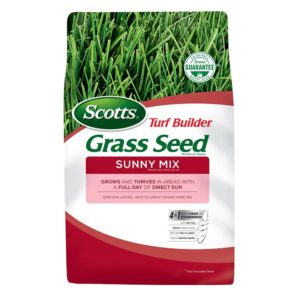
It’s easier to grow grass in full sun than in shady parts of your lawn, but it might take a special mix like Scotts Turf Builder Sunny Seed Mix. Full sun can quickly burn out a lawn when those dog days of summer come around. This specially formulated grass seed from Scotts includes a mix of heat-tolerant grass seeds.
These grass seeds are treated with Scott’s 4-in-1 WaterSmart PLUS coating, which helps the seeds absorb twice as much water as uncoated seeds. The coating also fertilizes the seed and protects it from disease, helping to speed along germination and growth. This sun-tolerant mix is designed for northern lawns. A 3-pound bag is enough to cover up to 1,200 square feet.
Best For Warm Season
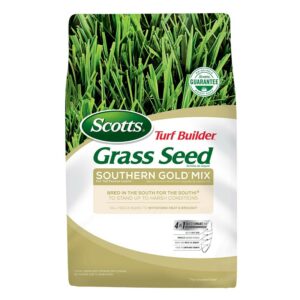
Summer weather in the South can be downright brutal with scorching heat and high humidity, but Scotts Turf Builder Southern Gold Seed Mix prevents having a lawn that quickly turns from lush green in June to dry brown by August. The seed mix features grass types that can survive the harshest summer conditions.
This seed also features Scott’s 4 in 1 WaterSmart PLUS coating. This treatment improves the seeds’ performance in drought conditions by enabling them to retain water more efficiently. It also fertilizes the seeds and protects them from disease. Scotts has designed this grass seed specifically for transition zone lawns. These yards must survive colliding climate zones of their region. Scotts Southern Gold Mix comes in various sizes with a 7-pound bag covering about 1,750 square feet.
Best For Cool Season
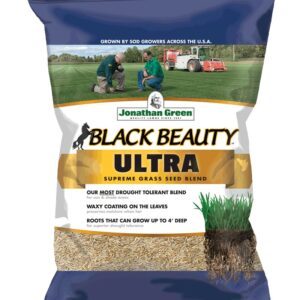
A good cool-season grass seed blend like Jonathan Green 10323 Black Beauty Ultra Mixture will give you a mix of grasses best suited for cooler and northern climates. The company is open about its mix, so purchasers know exactly what they’re getting in this blend.
This mix includes three different types of cool-season grasses: 80 percent tall fescue, 10 percent Kentucky bluegrass, and 10 percent ryegrass. Black Beauty seed features a waxy coating that protects each seed from diseases and will preserve plant moisture. A 25-pound bag will cover up to 10,000 square feet.
Best For Dense Shade
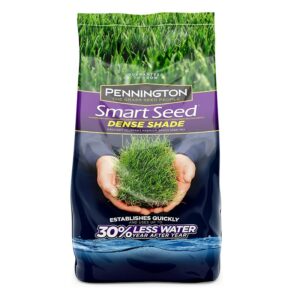
Most grasses grow best with a good daily dose of sunlight and it takes a special mix like this Pennington Smart Seed Dense Shade Grass Seed to equally fill those shaded parts of a yard. This mix is intended for areas of a lawn that only get about 2 to 4 hours of sun a day. As with other Pennington seeds, the dense shade mix has the company’s Penkoted technology that coats the seed with a special fertilizer to help it grow through those delicate seedling stages.
Best For High Traffic
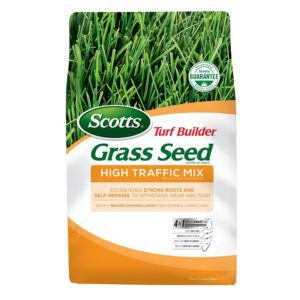
Those well-trodden areas of your yard can take a real beating and Scotts Turf Builder High-Traffic Grass Seed Mix helps a lawn hold up to dogs, kids, and backyard parties. For families who use their yards for more than just show, this high-traffic mix of grass seed from Scotts will grow quickly and self-repair worn-down spots in those areas that see a lot of activity.
The high-traffic mix features Scott’s proprietary 4-in-1 WaterSmart PLUS coating, which gives the seeds a boost while promoting water absorption. This mix is an excellent option for patching worn-out parts of the lawn or thickening up an entire turf area. A 7-pound bag provides enough coverage for up to 1,500 square feet.
Best Kentucky Bluegrass
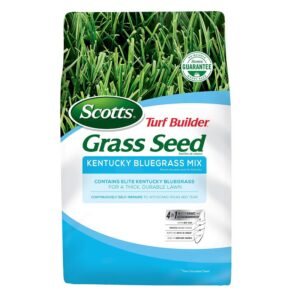
Homeowners who dream of the perfect green and lush lawn usually have Kentucky bluegrass in mind, and Scotts Turf Builder Bluegrass Mix has a mix of the popular grass for both full sun and light shade. It’s also formulated to self-repair and endure foot traffic, making it both durable and low-maintenance.
Although Kentucky bluegrass can be susceptible to drought, Scott’s mix is designed to endure dry summers, thanks to its proprietary seed coating technology, which provides nutrients while protecting the seed from fertilizer and enabling it to absorb water better. Scotts Kentucky Bluegrass Mix does best in northern regions. A 3-pound bag will cover up to 2,000 square feet.
Best Bermuda Grass
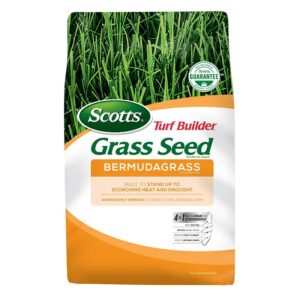
Growing grass in the southern regions of the country that see scorching hot temperatures can feel like an exercise in futility, but Scotts 18353 Turf Builder Bermuda grass can weather these harsh climates. With its high tolerance for drought, intense heat, and humidity, Bermuda grass might be the answer. The grass grows rapidly, and this Scotts mix will grow even faster, thanks to its 4 in 1 WaterSmart Plus coating, which can absorb twice as much water as uncoated seeds. The treatment helps seedlings enter the world strong, healthy, and ready to grow. A 5-pound bag of Bermudagrass turf builder is enough to cover up to 1,500 square feet.
Best Fast Growing
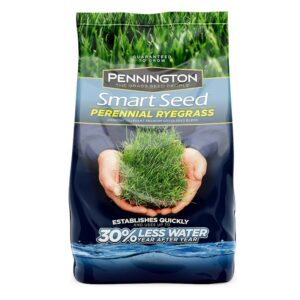
If you don’t like waiting weeks to see if those grass seeds you so carefully planted will grow, it’s best to go with ryegrass seed like this Pennington Smart Seed Perennial Ryegrass. The ryegrass germinates more quickly and grows faster than other grass seeds. It also maintains a deep green color year-round—you won’t have to look at a brown lawn all winter long. Pennington’s ryegrass seed can take as little as 7 days to germinate, far less than other grasses that can take up to four weeks.
Pennington’s seeds also develop denser root systems, which makes them more drought tolerant. This ryegrass seed also includes its Penkoted seal, which protects the seeds from mold while enabling them to retain moisture.
Best Low Maintenance
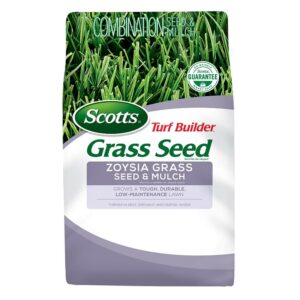
Shade, full sun, heavy foot traffic, scorching heat, cold, drought, even salt water matter little with Scotts Turf Builder Zoysia Grass Seed. Zoysia grass holds up well against most elements the climate or a busy lawn owner can throw at it. It even requires less mowing because it grows so slowly. If you’re looking for a low maintenance lawn, consider zoysia grass. Although it can grow in northern regions, this variety of grass does particularly well in the South.
Most zoysia grass must be planted as plugs or turf. This mix from Scotts will grow from seed, using a grass seed and mulch combination to speed the germination and growth process. A 5-pound bag is enough to cover a 2,000 square-foot area.
The Advantages of Buying the Best Grass Seed
Buying quality seed is essential to successfully start a new lawn or add thickness to an existing one. The best seed features coatings that make each seed less susceptible to mold and disease while enhancing its ability to absorb and retain water. High-quality seed also has a higher germination rate to help ensure that a good percentage of the seed you’ve invested in actually germinates. The last thing you want is to go to the trouble of planting grass seed only to grow weeds. Many cheaper grass seeds include some percentage of weed seed, while quality grass seed contains very little weed seed.
- High-quality seed is treated to maximize water retention, jump-start growth, and prevent disease.
- The best grass seed has a high germination rate of at least 90 percent.
- The best grass seed includes little to no weed seed.
FAQs About Grass Seed
If you’re still wondering what product is best for you, read on for answers to your most pressing grass seed questions.
Q. What month is best for planting grass seed?
The best month for planting grass seed is September for cool-season grasses and May for warm-season grasses, although this can vary depending on where you live. For cool-season grasses, you want a combination of warm soil, moderate temperatures during the day, and cool temperatures at night. Warm-season grasses should be planted when temperatures eclipse 80 degrees during the day and remain warm through the night.
Q. How do you seed a lawn?
Once you’ve purchased your seed, you’ll need to prepare the soil. If reseeding, cut the grass to a height of 1.5 to 2 inches. Lightly rake the area to break up the soil’s surface, so it can receive the seeds. For new lawns, prepare the ground, making sure to even out the surface. Use a spreader to distribute the recommended amount of seed for reseeding or planting a new lawn.
Q. How do you prepare ground for grass seed?
If possible, use a soil test kit to determine the pH of your soil. Depending on the results, you might need to add organic matter such as lyme, compost, topsoil, or peat moss to your soil. Once you’ve completed that step, break up the top 1/2-inch of the earth with a rake. The soil needs to be loose to accept the seeds.
Q. Can you mix grass seed with topsoil?
Mixing grass seed with topsoil is not a good idea. By combining the two, it’s difficult to spread the seeds evenly throughout the yard. It also might cause some seeds to be buried too deep into the soil to germinate and grow. For better results, spread the seed after mixing topsoil into the yard.
Q. Do you need to cover grass seed?
It’s best not to cover the grass seed with topsoil. Grass seeds are not strong enough to push through heavy earth after germinating. Covering the seeds with topsoil suffocates them, preventing them from growing.
tinyurlis.gdv.gdv.htclck.ruulvis.netshrtco.detny.im
مقالات مشابه
- تحلیل خبری: بایدن در میان چالش ها «اجلاس سران دموکراسی» را برگزار کرد
- چه چیزی برج خنک کننده را کاملاً متفاوت می سازد
- شرکت صادرات و واردات کالاهای مختلف از جمله کاشی و سرامیک و ارائه دهنده خدمات ترانزیت و بارگیری دریایی و ریلی و ترخیص کالا برای کشورهای مختلف از جمله روسیه و کشورهای حوزه cis و سایر نقاط جهان - بازرگانی علی قانعی
- خیلی زود به بگویید اگر Bonhomme ریچارد را می توان نجات داد پس از آتش نیروی دریایی می گوید
- AP های منحصر به فرد: عدالت Dept انداختن بازنشسته ارتش ژنرال مایک فلین پرونده جنایی
- Former Missile Defense Agency Chief Harassed Female Employee for 7 Years, IG Finds
- لوله پلیکا سایز بزرگ جداره چاه - مرجع بزرگ خرید و فروش لوله
- USNS راحتی می شود خاموش بازگشت به خانه در نورفولک پس از Coronavirus کار در نیویورک
- پرستار سالمند به چه کسی میگویند؟
- راز قلعه بادی